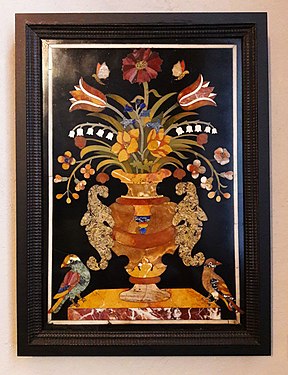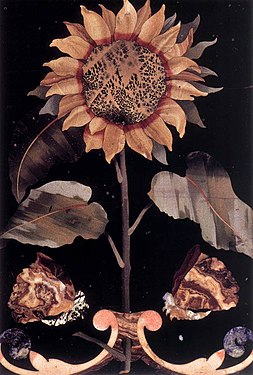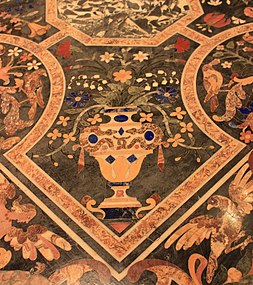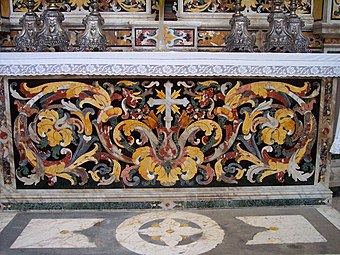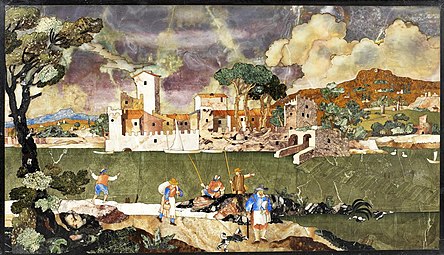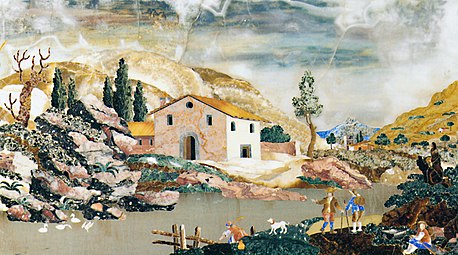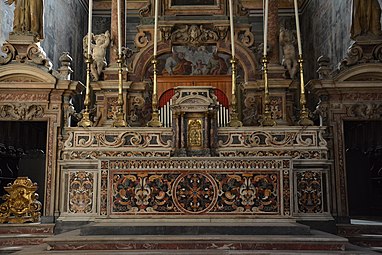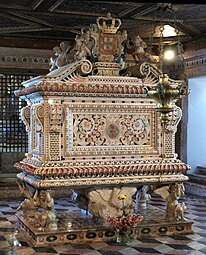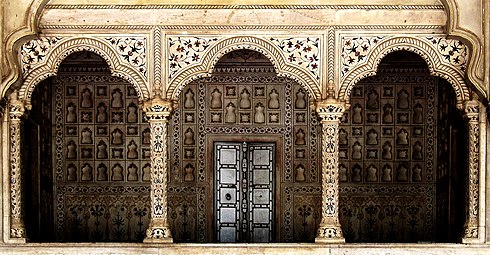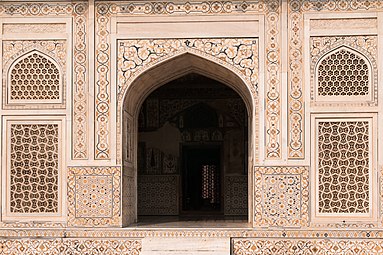Pietra dura

Pietra dura (it. „harter Stein“) – „Florentiner Mosaik“, die Kunst der Verlegung von Bildern und Ornamenten aus Plättchen aus harten Steinsorten (Achat, Chalcedon, Jaspis, Lapis lazuli, sowie Perlmutt und Koralle).
Anders als im Falle der klassischen Mosaikkunst aus bunten Würfeln oder Stiften, verwendet das Pietra-dura-Verfahren genau angepasste Formstücke, die den größeren Fragmenten der Komposition entsprechen. Als Klebstoff dient Mastixkitt. Fertige Mosaiken werden spiegelglatt geschliffen. So entstehen besonders widerstandsfähige, dauerhafte dekorative Oberflächen. Die Blüte des Pietra-dura-Handwerks entfiel auf das 16. Jahrhundert, insbesondere in Florenz. Auch in unseren Zeiten werden in Florenz kleine Souvenirs aus Pietra dura hergestellt. In Florenz in der via degli Alfani 78 befindet sich das Museo dell’Opificio delle Pietre Dure, mit einer Werkstatt, die den Besuchern die Herstellung der Kunstwerke zeigt.
Das Verfahren findet sich aber nicht nur in Italien, sondern gelangte bis nach Indien. Auch das Taj Mahal wurde auf diese Weise verziert.
Galerie
Pietra-dura-Bild mit Blumenvase und Vögeln, um 1620, Florenz oder Prag. Bayerisches Nationalmuseum, München
Mosaik aus der Medici-Kapelle, Florenz
Sonnenblume in Pietra dura, Anonymus 1664. Opificio delle pietre dure, Florenz
Pietra-dura-Tischplatte, Florenz um 1620. Victoria and Albert Museum
Pietra-dura-Tischplatte mit Papagei auf Birnbaumzweig im Zentrum, Italien, 1. Viertel des 18. Jahrhunderts. Warschauer Königsschloss
Altar-Antependium mit dem heiligen Angelus, Blumen, Früchten und Vögeln, 1647, Florenz
Antependium des Altars in der Kathedrale von Dubrovnik
Landschaftsbild in Pietra dura, 17. Jahrhundert. Großherzogliche Werkstätten, Florenz (zugeschrieben)
Pietra-dura-Landschaft von Baccio Cappelli,
frühes 18. Jahrhundert
Capellone di Sant’Ignazio di Loyola in der Kirche Gesù Nuovo, Neapel. Marmorarbeiten von Cosimo Fanzago (1591–1678)
Hauptaltar der Kirche
Santa Maria la Nova (Neapel),
von Cosimo FanzagoGrabmal der Princesa Santa Joana, spätes 17. Jahrhundert, im Mosteiro de Jesus, Aveiro (Portugal)
Balkon des Mogul-Kaisers am Diwan-i-Am,
Fort Agra, IndienSüdliches Tor am Itimad-ud-Daula-Mausoleum, Agra, Indien
Literatur
- Rolf C. Wirtz, Clemente Manenti: Kunst und Architektur Florenz. Ullmann/Tandem 2005, ISBN 978-3-8331-1302-4
- Annapaula Pampaloni Martelli: Museo dell’Opificio delle Pietre Dure di Firenze. Arnaud, Firenze 1975.
- Annamaria Giusti: Pietra Dura. Hirmer Verlag, München 2005, ISBN 978-3-7774-2745-4
Weblinks
Auf dieser Seite verwendete Medien
Pietre dure panel depicting a coastal scene attributed to the Grand Ducal workshops in Florence, 17th century, 59 x 34.5 cm (23 x 13.5 in),
(c) Daniel Villafruela, CC BY-SA 3.0
Dieses Bild zeigt das ASI-Denkmal mit der Nummer
Autor/Urheber: Doma, Lizenz: CC BY-SA 3.0
Emblem of Florence (Mosaic), Basilica of San Lorenzo (Medici Chapel)
Autor/Urheber: Wikipedia Loves Art participant "va_va_val", Lizenz: CC BY-SA 2.5
Table top
Italian, Florence, about 1620
The top inlaid with various marbles known in Florence as pietre dure.
Pietre dure (literally 'hard stones' was first developed in Rome from about 1550. In 1588, Grand Duke Ferdinando I of Tuscany (reigned 1587-1609) set up a workshop, the Galleria dei Lavori di Pietre Dure, at the Uffizzi Gallery in Florence. Florentine examples were more flamboyant and included representations of birds, vases, flowers, and fruit, whereas Roman ones consisted more often of large sections of unadorned marble, surrounded by borders containing more restrained abstract patterns.
449-1869
This photo of item # 449-1869 at the Victoria and Albert Museum was contributed under the team name "va_va_val" as part of the Wikipedia Loves Art project in February 2009.
Victoria and Albert Museum
Autor/Urheber: Arefin.86, Lizenz: CC BY-SA 3.0
Dieses Bild zeigt das ASI-Denkmal mit der Nummer
Autor/Urheber: IlSistemone, Lizenz: CC BY-SA 4.0
Chiesa del Gesù Nuovo (Napoli) - Transetto sinistro
Portrait of Pope Clement VIII (Ippolito Aldobrandini); Designed by Jacopo Ligozzi (Italian, 1547 - 1627), produced in the Galleria de'Lavori in pietre dure (Italian, founded 1588), Executed by Tadda (Romolo di Francesco Ferrucci) (Italian, 1544 - 1621); 1600–1601; Marble, lapis lazuli, mother-of-pearl, limestone, and calcite (some covering painted paper or fabric cartouches) on and surrounded by a silicate black stone; 97 × 68 cm (38 3/16 × 26 3/4 in.); 92.SE.67. No Copyright - United States (http://rightsstatements.org/vocab/NoC-US/1.0/)
Cathedral of the Assumption of the Virgin Mary (or Velika Gospa) in Dubrovnik (Croatia)
Autor/Urheber: Sailko, Lizenz: CC BY-SA 4.0
Dieses Bild zeigt ein Denkmal, das zum Kulturerbe Italiens gehört. Dieses Denkmal nimmt am Wettbewerb Wiki Loves Monuments Italia 2017 teil.
Autor/Urheber: Alvesgaspar, Lizenz: CC BY-SA 3.0
Tomb of blessed Joan of Portugal, in the Convento de Jesus at Aveiro, Portugal. Marble work of 17th century
Autor/Urheber: Mentnafunangann, Lizenz: CC BY-SA 4.0
Chiesa di Santa Maria la Nova a Napoli
